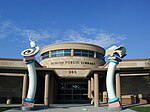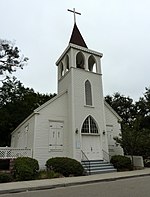West Dublin/Pleasanton station
Amador ValleyBay Area Rapid Transit stations in Alameda County, CaliforniaDublin, CaliforniaPleasanton, CaliforniaRailway stations in the United States opened in 2011 ... and 1 more
Stations on the Blue Line (BART)

West Dublin/Pleasanton is a Bay Area Rapid Transit (BART) station on the border of Dublin and Pleasanton in California, located in the median of I-580. It opened as an infill station on the Blue Line on February 19, 2011 — fourteen years after the rest of the line. The station has a single island platform located at the level of the highway travel lanes. The fare mezzanine is above the platform and tracks. Pedestrian bridges on both sides of the station connect it to a pair of parking garages and surrounding development.
Excerpt from the Wikipedia article West Dublin/Pleasanton station (License: CC BY-SA 3.0, Authors, Images).West Dublin/Pleasanton station
Arthur H. Breed Junior Freeway,
Geographical coordinates (GPS) Address External links Nearby Places Show on map
Geographical coordinates (GPS)
| Latitude | Longitude |
|---|---|
| N 37.699726 ° | E -121.928273 ° |
Address
West Dublin/Pleasanton
Arthur H. Breed Junior Freeway
94588
California, United States
Open on Google Maps





